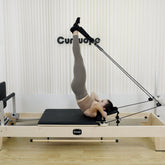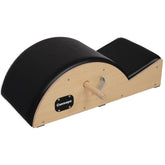What are the differences between Pilates equipment for home and studio use?
Pilates is a popular form of exercise that can be practiced in both home and studio settings. While the fundamentals of Pilates remain the same, there are some key differences between the equipment used in each setting. In this article, we'll explore the differences between Pilates equipment for home and studio use.

Home Pilates Equipment
Pilates equipment designed for home use is typically smaller, more portable, and more affordable than equipment found in studios. Home Pilates equipment often includes items such as mats, resistance bands, foam rollers, and small Pilates balls. These pieces of equipment are ideal for beginners or for those who prefer to practice Pilates in the comfort of their own homes.
One of the key benefits of home Pilates equipment is its affordability. Many items can be purchased for under $50, making it accessible to a wide range of individuals. Additionally, home equipment is typically more portable, which allows for greater flexibility in terms of where and when Pilates can be practiced.
Studio Pilates Equipment
Pilates equipment found in studios is typically larger, more advanced, and more expensive than home equipment. The most common types of equipment found in Pilates studios include the Pilates reformer, Cadillac, Wunda chair, and spine corrector. These pieces of equipment are designed to offer a wide range of exercises that target multiple muscle groups and fitness goals.
One of the key benefits of studio Pilates equipment is its versatility. The equipment is designed to be adjusted and customized to meet the needs of each individual, making it ideal for both beginners and advanced practitioners. Additionally, studio equipment is typically more durable and long-lasting than home equipment, which means it can withstand frequent use and heavy wear.
Another benefit of studio Pilates equipment is the guidance and support offered by trained instructors. Instructors are able to provide personalized feedback and modifications to ensure that each individual is using the equipment correctly and safely. This level of support is not typically available with home equipment.
In conclusion, while both home and studio Pilates equipment offer a range of benefits, there are some key differences to consider. Home equipment is typically more affordable, portable, and accessible to beginners. Studio equipment, on the other hand, is larger, more advanced, and offers a greater range of exercises and customization options. Additionally, the guidance and support of trained instructors is a valuable benefit of studio Pilates equipment. Ultimately, the choice between home and studio equipment will depend on individual preferences, goals, and budget.





